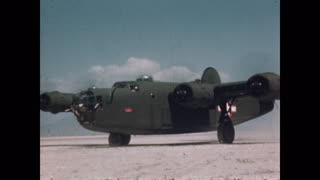Produced by Consolidated Vultee Aircraft Corporation, Flying The B-24 is a short instructional film that covers “certain of the more fundamental procedures surrounding the handling of the B-24 [four-engine] bomber in flight.” The film uses actual footage of the ship performing the various operations described, complementing exterior shots of the B-24 with matching footage from the cockpit for each maneuver. The film opens with a B-24 on a sandy runway preparing for takeoff (01:21). A pilot sits in the cockpit and begins takeoff operations. The ship takes flight at 150 mph. Footage from the cockpit shows the crew reducing power (03:00), which is followed by a shot of a propeller. The crew blends propeller shadows (03:47). The B-24 climbs 1,000 feet per minute. In the cockpit, the crew monitors the rate of climb (04:45), oil pressure, fuel pressure, and oil temperature. The B-52 climbs to its cruising altitude of 9,000 feet by climbing a little over 9,000 feet then dropping down to that altitude. The copilot resynchronizes the propellers (07:23). The B-52 tries to gain speed under reduced power (08:45). A member of the crew checks to make sure that the flaps and landing gear are fully retracted (09:22) and that the turrets are facing the tail to minimize drag. Footage shows the manifold pressure gauges (11:00). The ship climbs to a higher altitude, and there is good shot of the B-24 flying over mountains (12:23). The plane banks at a 30-degree turn maintaining altitude (12:50), then performs a 60-degree turn (13:25). The next operation is climbing elevation in order to dive the ship (14:44; 16:25). Speed is then reduced to 150 mph for maneuvers with flaps extended (17:34), including turns (17:50; 18:40; 19:30), a stall with power off (20:57; 21:20), and a stall with flaps and gear down (22:14; 22:37). The B-24 climbs to 9,200 feet (24:26) before leveling off at 9,000 feet, then the crew feathers the engines (25:00), increasing manifold pressure and stopping one engine in order to fly with only three engines (25:57). The ship performs a turn away from the dead engine (26:30), followed by a turn toward the dead engine (26:57). The second engine is shut down (27:35) so only one side of the plane’s engines are on. This still allows for flight, but the ship must be flown cautiously. The B-24 turns away from the dead engines (28:08) and then performs a turn toward the dead engines (28:30; 29:09). The crew restarts the second engine (29:40), then the first, holding down the prop feathering switch until the propeller hits 1,000 rpms. The film concludes with a shot of the B-24 flying with mountains in background (31:10).
We encourage viewers to add comments and, especially, to provide additional information about our videos by adding a comment! See something interesting? Tell people what it is and what they can see by writing something for example: “01:00:12:00 — President Roosevelt is seen meeting with Winston Churchill at the Quebec Conference.”
This film is part of the Periscope Film LLC archive, one of the largest historic military, transportation, and aviation stock footage collections in the USA. Entirely film backed, this material is available for licensing in 24p HD, 2k and 4k. For more information visit http://www.PeriscopeFilm.com


